Strap in, adrenaline-seekers, and welcome to the exhilarating world of long-distance electric skateboarding — a journey where the wind is your friend, and the miles your playground. Whether you’re a seasoned rider or a curious newbie, this article is your ultimate guide to mastering the art of extended rides. From essential gear and equipment, optimal techniques tailored for long distances, to careful planning of your trip, we’ve got you covered. But that’s not all. We’ll also walk you through navigating varied terrain and weather conditions, safety measures, and post-ride maintenance to keep you cruising smoothly for many miles to come.
What we’ll cover:
- Embracing the Journey
- Gear and Equipment
- Techniques for Extended Rides
- Trip Planning
- Battery Efficiency
- Navigating Varied Terrain and Weather
- Post-Ride Maintenance
So go ahead, gear up, plug in, and let’s dive into the electrifying realm of long-distance electric skateboarding.
Introduction to Long Distance Electric Skateboarding: Embracing the Journey
One of the most exhilarating experiences you can have is riding an electric skateboard for long distances. It’s not just about the speed and thrill though, it’s also about embracing the journey and the sense of adventure that comes with it. But, to truly enjoy such an experience, it requires some preparation and understanding.
Electric skateboarding tips for long distances can be incredibly helpful for beginners. It’s important to know that riding an electric skateboard isn’t just about hopping on and zooming off. It requires practice, balance, and a bit of physical endurance. Just like any sport or outdoor activity, you need to condition your body and mind to get the most out of the experience.
Embracing the Journey
Riding an electric skateboard for long distances is a unique experience. It’s not just about getting from point A to point B. It’s about enjoying the ride, feeling the wheels gliding smoothly over asphalt, and taking in the surroundings. The journey can be as thrilling as the destination, if not more so.
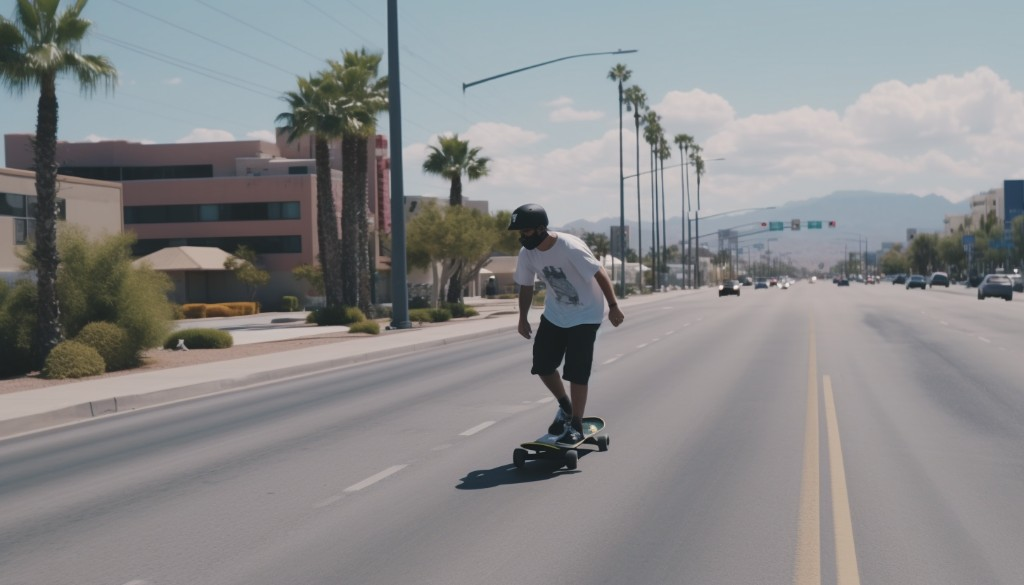
Fitness and Endurance: Building the Strength for Long Rides
Physical fitness plays a significant role in electric skateboarding. You have to have good balance, core strength and endurance to handle long rides. The longer the distance, the more energy you need. Proper hydration is also key. It’s important to drink plenty of water before, during, and after your ride to remain hydrated and avoid fatigue.
Building Endurance
Endurance is vital when you want to ride an electric skateboard for long distances. To build up your endurance, start by going on shorter rides and gradually increase the distance as your stamina improves. Regular exercise off the board can also help build strength and endurance.
Importance of Hydration
Hydration plays a crucial role in riding an electric skateboard for long distances. Dehydration can lead to fatigue, a decrease in coordination, and even muscle cramps. Therefore, drinking plenty of water before you start, and carrying a hydration pack with you during your ride can help keep you hydrated.
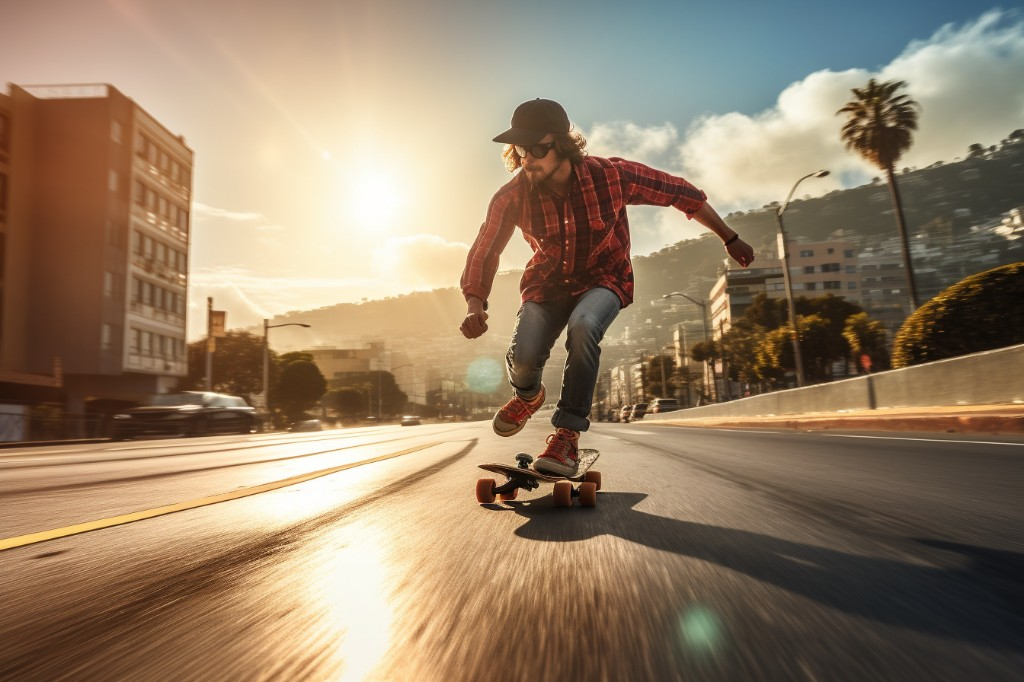
Nutrition for Long Rides: Powering Your Journey
Nutrition is another important aspect to consider when planning for a long electric skateboarding journey. It’s not just about eating a healthy meal before you set off; it’s also about replenishing your energy levels during the ride. Some essentials that are easy to carry and consume on the go are fruit, energy bars, and nuts.
Pre-Ride Nutrition
The food you consume before your ride can significantly impact your performance on the board. Aim for a balanced meal that includes carbohydrates for energy, protein for muscle repair, and some healthy fats for sustained energy release.
On-The-Go Nutrition
During long rides, refueling is crucial. Portable options like bananas, apples, or energy bars are great choices as they provide a quick source of energy without being too heavy or hard to digest.
Post-Ride Nutrition
After a long day of riding an electric skateboard, your muscles will need some recovery nutrients. A balanced meal with a good mix of protein, carbohydrates, and fats can help replenish energy stores and repair muscle tissue.
Isn’t it exciting? The world of long-distance electric skateboarding is full of adventures waiting to be experienced. With these tips at hand and proper fitness, hydration, and nutrition strategies, you’re all set to embrace the journey!
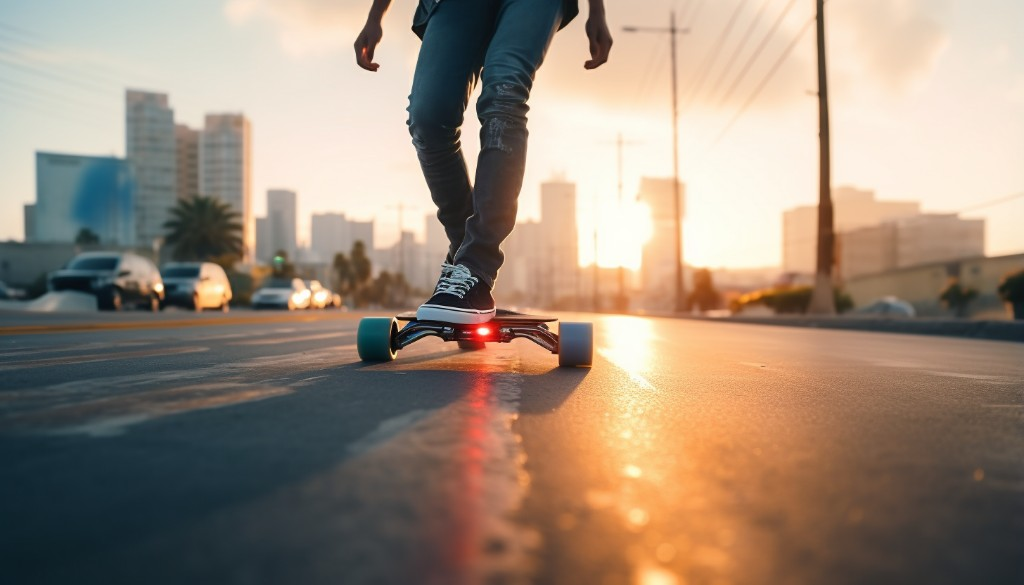
Pre-Ride Essentials: Gear and Equipment
Equipping oneself with the right safety gear is vital for every ride, particularly for those who love the thrill of speed and are eager to get on their boards. This includes everything from a helmet to knee and elbow pads, and even wrist guards. Remember, it doesn’t matter how experienced or skilled you are, accidents are unpredictable and can happen to anyone.
When preparing for a ride, make sure you’re wearing a helmet. This is your first line of defence against serious head injuries. Even a minor fall can result in a concussion if you’re not wearing a helmet. It’s also crucial to protect your knees and elbows with knee pads and elbow pads. These areas are prone to scrapes and bruises, especially when learning new tricks or if you take a tumble.
Wrist guards are another essential piece of safety gear, often underestimated by riders. Falling on an outstretched hand can lead to sprains or fractures, so it’s wise to wear these guards as an extra layer of protection.
It’s not just about protective gear, though. Your clothing choices can make a big difference in your riding experience. Opt for comfortable clothing that’s neither too tight nor too loose. Comfortable attire will allow for easy movement and better control over your board. You may also choose to invest in padded shorts or a jacket to provide additional safety for your ride.
Last but certainly not least is the choice of footwear. Your shoes should offer good grip, fitting comfortably without being too snug. They should also have flat soles for stability and effective control of the board.
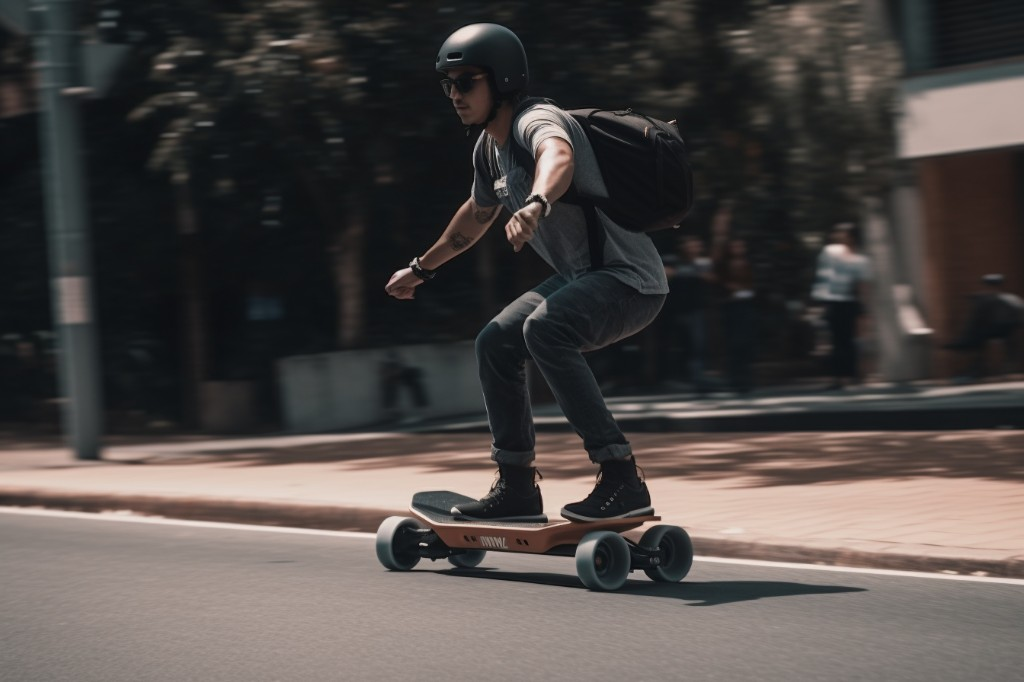
The Role of the Board and Remote Control
The board itself and the remote control hold significant importance in your riding experience. The board weight, for instance, can influence your agility on the board. Heavier boards might be more stable at high speeds, but may also be less manoeuvrable. Therefore, it is crucial to find a board that suits your weight and riding style.
Electric skateboard maintenance is another factor riders must pay attention to. Regular upkeep like checking tire pressure, cleaning the deck, and ensuring the bearings are well lubricated will extend the board’s lifespan and performance. Remember to keep the tire pressure at the manufacturer’s recommended level for the best riding experience.
In terms of power, understanding your board’s motor power and battery life is essential for managing long rides. More motor power usually means higher speeds, but also increased battery consumption. Likewise, a longer battery life promises more extended rides but may demand a heavier battery on your board.
The remote control is your link to controlling the board’s speed and direction. It should be easy to hold and operate, offering smooth control over acceleration and braking. Being familiar with how your remote control works will improve your overall ride control and safety.
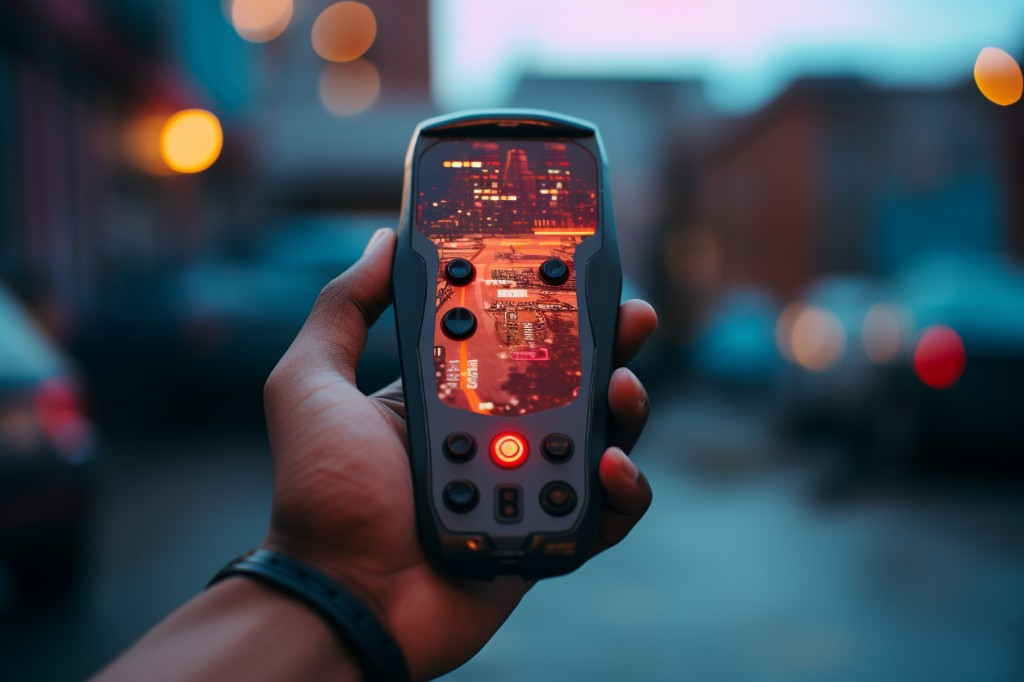
Advanced Features of Modern Electric Skateboards
Over time, electric skateboards have seen considerable technological advancements and improvements in features that enhance the riding experience. One such advanced feature is increased battery capacity. Modern electric skateboards now come with larger batteries capable of providing longer rides before needing to recharge.
Furthermore, electric skateboards now come with features like regenerative braking systems. This innovative feature allows the board to regain some energy when you brake or go downhill, converting kinetic energy back into battery power.
With these advanced features integrated into modern electric skateboards, rides have become more efficient, safer, and enjoyable than ever before. So whether you’re a seasoned rider or a beginner looking to get into the sport, there’s no denying that today’s electric skateboards offer an unparalleled experience.
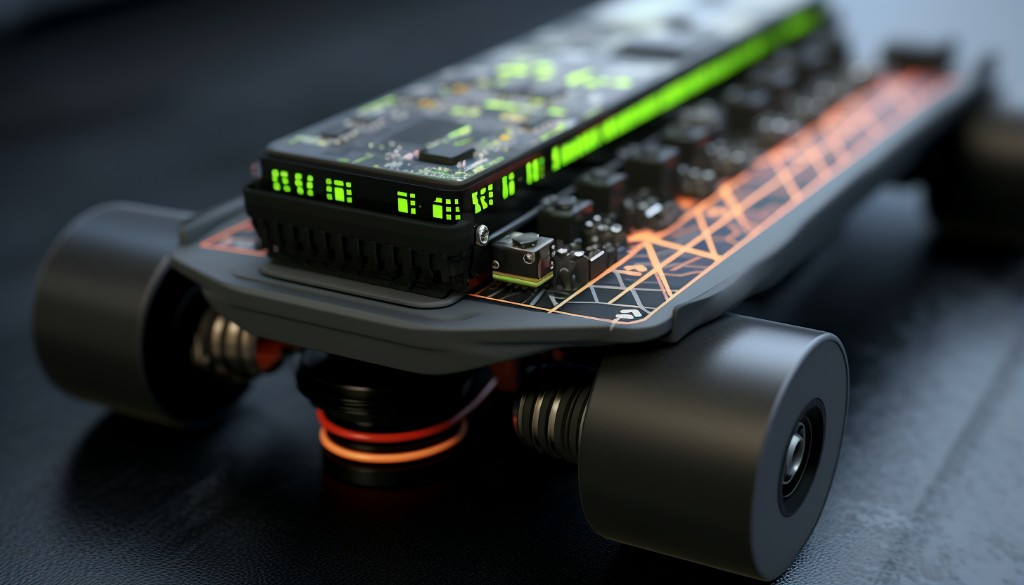
Optimal Techniques for Long Distance Electric Skateboarding
The joy of electric skateboarding, especially over long distances, undeniably hinges on mastering some fundamental riding techniques. These techniques, such as establishing a proper foot position, effectively managing speed control, and fine-tuning your acceleration control, are critical to maximize the thrill and safety of your ride.
Electric skateboarders often debate the ideal foot position, but it generally involves placing your feet over the trucks, while making sure they’re comfortably apart. Balancing your weight distribution across both toes and heels helps with smoother acceleration and deceleration. Speaking of deceleration control, it’s essential to gradually ease off the throttle to avoid sudden stops that may lead to accidents.
On the flip side, acceleration control demands a steady increase in speed to maintain stability. It’s tempting to floor the throttle for a quick burst of speed, but a gradual increase helps maintain balance and control. This leads us to speed control, which goes hand in hand with acceleration control. Controlling your speed is paramount especially when riding in crowded areas or on unpredictable terrain.
Lastly, the turning technique is about shifting your body weight to initiate turns. Remember to bend your knees and lower your center of gravity. This not only helps in executing sharper turns but also improves your overall control. So, bend your knees, get low, and turn like a pro!

Handling the Ride at High Speeds
Once you’ve mastered the basic riding techniques, it’s time to tackle the adrenaline rush of high speeds. Riding at high speeds can be exhilarating, but it comes with its own set of challenges. One such challenge is maintaining your riding speed while being aware of your energy consumption.
High speeds mean more energy consumption. This can lead to a quicker drain on your battery, reducing the range of your board. Therefore, it’s crucial to find a balance between the thrill of speed and the practicality of energy management. Remember, energy consumption increases exponentially with speed, so keeping a moderate pace can significantly extend your ride.
Another factor to consider is stability. High-speed riding requires excellent balance and reflexes. It’s essential for you to bend your knees for better stability and prepare for any unexpected obstacles or changes in terrain.
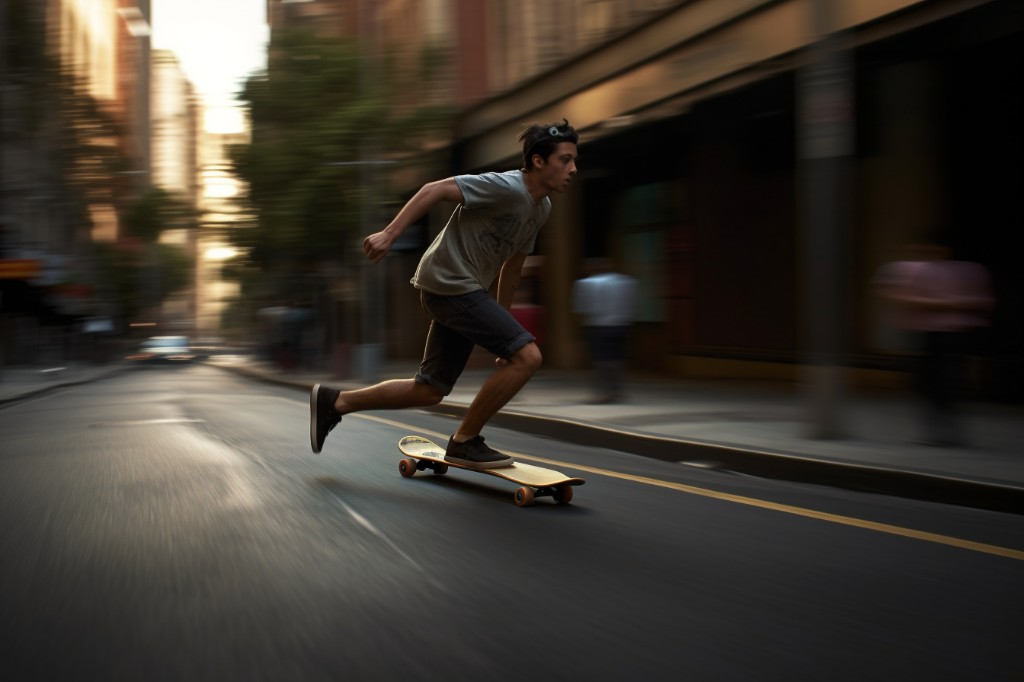
Hill Climbing and Other Challenges
The beauty of electric skateboarding lies in its versatility – you’re not restricted to flat terrains. However, more varied terrains like uphill slopes introduce additional challenges such as hill climbing.
Hill climbing on an electric skateboard can be a true test of your skills and stamina. The key is to lean forward slightly as you climb up and apply steady acceleration. Engaging in regular practice will equip you with the necessary muscle memory for more difficult climbs.
While riding against the wind may sound poetic, in practical terms it can be quite challenging. Be it a headwind or a crosswind, both can adversely affect your control and energy consumption. But don’t worry too much! The trick to tackling wind challenges is to minimize your surface area by leaning forward and staying low.
Overall, taking on these challenges can significantly improve your electric skateboarding skills for long distances. After all, who doesn’t love a little extra thrill in their ride?
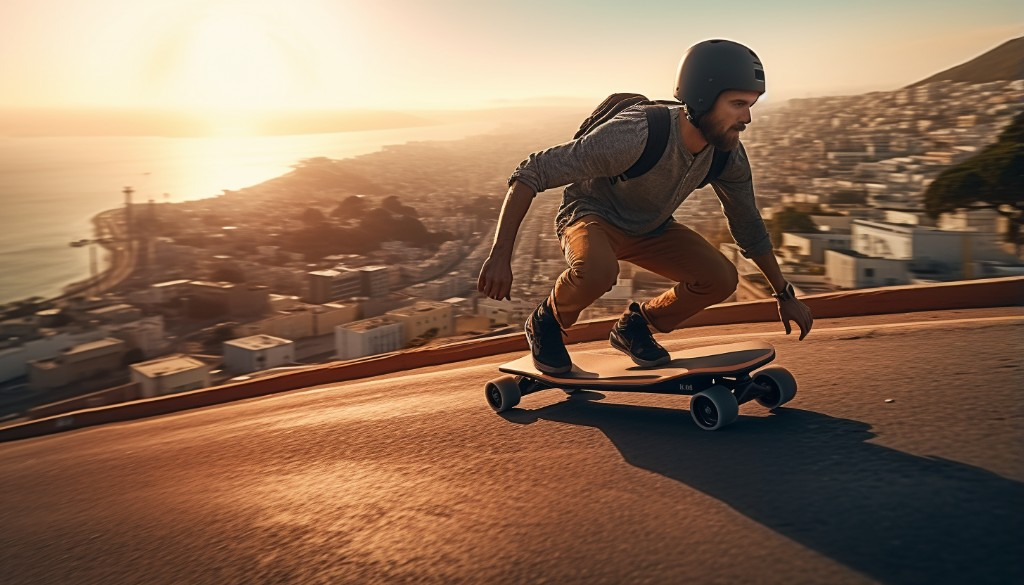
Planning a Long Distance Electric Skateboarding Trip
Planning an electric skateboarding trip, especially a long-distance one, is no small feat. It’s about more than just jumping on your board and taking off. You need to have a solid plan in place to ensure a smooth, enjoyable ride.
Why is Ride Planning Essential?
Ride planning is the cornerstone of any successful long-distance skateboarding journey. Without it, you’re essentially traveling blind. By taking the time to plan your ride, you can anticipate possible challenges and have solutions ready.
- Determine Your Endurance: How far can you travel on your board before you need a break? Knowing your limits can help you decide the length of your trip.
- Check Weather Conditions: Always check the weather forecast before you set off. Rain, snow, or extreme heat can ruin your trip.
- Pack Essentials: Don’t forget to pack key items such as water, snacks, spare parts, and tools for your electric skateboard.
The Significance of Route Planning
Route planning is another critical aspect of planning a long-distance skateboarding trip. It involves mapping out the path you’ll take from your starting point to your destination.
- Identify Safe Routes: Look for routes with smooth roads and light traffic. Avoid areas with steep hills or rough terrain that could damage your board.
- Plan for Breaks: Include stops along your route for rest and refreshments. This will help you maintain your energy levels throughout the trip.
The Importance of GPS tracking
GPS tracking can be a valuable tool during your skateboarding journey. It can guide you along your chosen route, help you track your progress, and even alert others to your location in case of an emergency.
- Stay on Track: Use a GPS device or app to follow your planned route without getting lost.
- Monitor Your Progress: GPS tracking lets you see how far you’ve traveled and how much longer you have to go.
- Safety First: Sharing your GPS location with someone at home can ensure help arrives promptly if needed.
Managing Battery Efficiency and Range Anxiety
When going on a long-distance electric skateboarding ride, battery efficiency and managing range anxiety are two factors that need careful consideration.
Understanding Battery Efficiency
Battery efficiency refers to how effectively your skateboard’s battery uses its stored energy. Maximizing this efficiency can greatly extend the distance you can travel on a single charge.
- Maintain Your Skateboard: Regular maintenance checks can keep your skateboard in top condition, enhancing its battery efficiency. Be sure to check for swelling and leaks, as these are signs of serious defects, which could result in a fire hazard. Moreover, be careful not to overcharge the battery and allow it time to cool down immediately after a ride. Ignoring these warnings may result in your battery draining more quickly, and a replacement being required sooner than necessary.
- Ride Sensibly: Avoiding high speeds and sudden acceleration can help conserve battery power.
Dealing with Range Anxiety
Range anxiety is the fear that your skateboard’s battery will run out before you reach your destination or a charging station. It’s a common concern among electric skateboarders, but there are ways to manage it.
- Know Your Skateboard’s Range: Understanding the distance your skateboard can travel on a full charge can help alleviate range anxiety.
- Have a Backup Plan: Identify potential charging stations along your route so that if you do run out of power, you know where to go.

Locating and Using Charging Stations
Locating charging stations along your route is crucial for long-distance electric skateboarding trips. They provide the opportunity to recharge your skateboard’s battery, allowing you to cover greater distances.
The Role of Charging Stations
Charging stations are places where you can plug in and recharge your electric skateboard’s battery. They might be official stations designed specifically for electric vehicles, or they could be outlets at coffee shops, parks, or libraries.
- Locate Charging Stations Ahead of Time: Use apps or websites to find charging stations along your route before you set off.
- Factor Charging Time into Your Plan: Charging takes time, so make sure to incorporate these breaks into your trip planning.
- Respect the Space: If you’re using a public outlet at a business, ask for permission first and buy something as a thank you for using their power.
By diligently planning your ride, managing battery efficiency, tackling range anxiety head-on and locating charging stations, you’re setting yourself up for a successful long-distance electric skateboarding trip. Just remember to enjoy the journey!
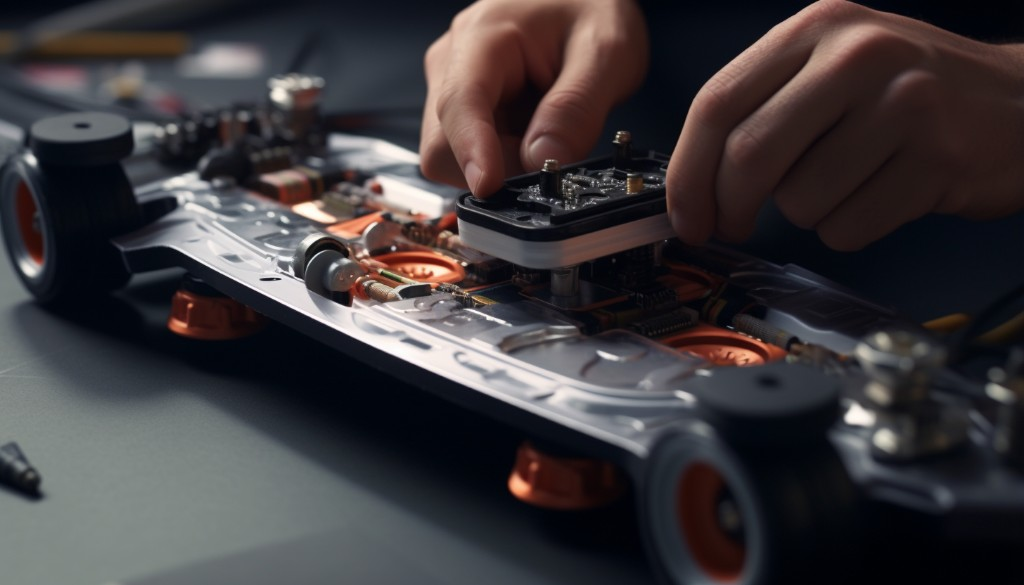
Spare Battery and Other Considerations
For those who enjoy long rides on their electric skateboards, having a spare battery can be a game-changer. A spare battery is not just about extending your ride time; it’s also about ensuring you don’t get stranded far from home with a dead battery.
Having a spare battery gives you peace of mind during your rides. It allows you to enjoy your ride without constantly worrying about battery level. Plus, using a spare battery can help you prolong the life of your batteries as you won’t be constantly draining one battery.
Having said that, always remember to take care of your spare battery just like your main one. Charge it regularly and store it properly to ensure it’s ready when you need it.
Navigating Varied Terrain and Weather Conditions
Navigating different types of terrain on your electric skateboard can be a challenging but rewarding experience. It not only tests your skateboarding skills but also your ability to resiliently adapt to different surroundings. Whether you are skateboarding through the city streets, a mountainous landscape, or tackling trails through a forest, understanding the terrain is key to having a smooth ride.
First off, let’s talk about skateboarding on hilly terrains. One thing you need to remember is that uphill skateboarding requires more energy, and it’s crucial to find the right pace while going uphill to conserve energy. On the other hand, when you’re descending, leaning back and keeping your weight over the rear of the board will provide much-needed stability.
Now, what about rocky trails? Here, it’s best to maintain a speed that allows you to navigate around rocks without losing control. It’s also important to remember that your line of sight should be far ahead, giving you ample time to plan your maneuvers.
Switching gears to weather conditions, it cannot be stressed enough how much they affect your skateboard ride. Let’s face it; skateboarding in the rain is not the same as cycling on a sunny day. Wet weather, for instance, affects visibility and makes surfaces slick, so it’s essential to adjust your speed accordingly and be extra cautious at bends and turns.
On the other side of the spectrum, hot weather conditions can cause dehydration, so keeping yourself hydrated is paramount. Also, remember to apply sunscreen to protect yourself from harmful UV rays.
Overall, understanding these factors and making necessary adjustments is crucial when navigating varied terrain and different weather conditions.
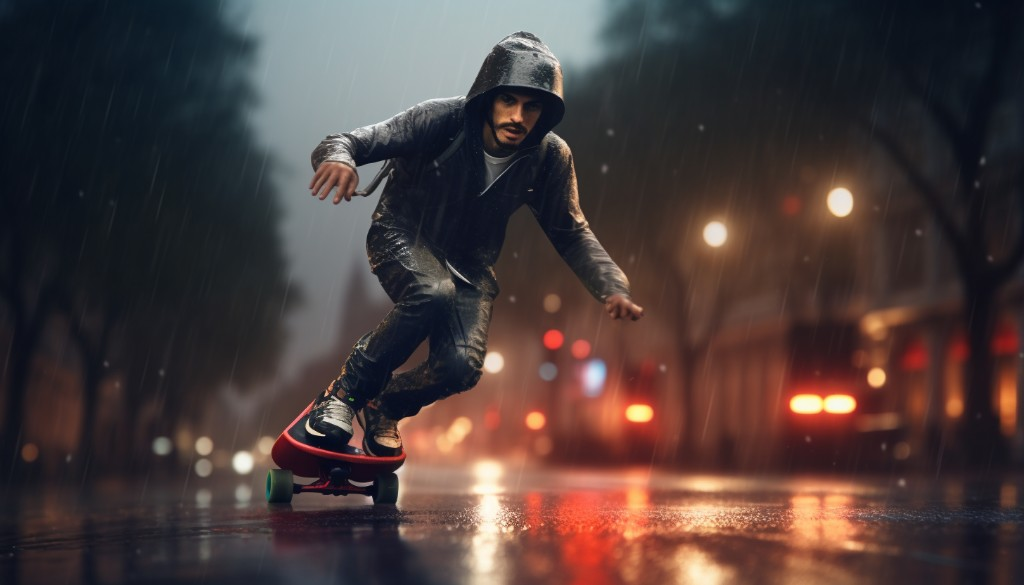
Night Riding and Visibility Considerations
Taking a spin on your electric skateboard during nightfall brings about its own set of challenges, with visibility being the main one. Therefore, enhancing visibility becomes the key focus when it comes to night riding.
A vital component for this is having adequate lighting equipment on your skateboard. A good set of front and rear lights not only helps you see better but also makes you visible to others on the road. Choosing lights with multiple modes like steady, flashing, or pulsing can be beneficial depending on the situation.
Coupled with lighting equipment, reflective clothing becomes another critical component for night riding. A reflective vest or jacket can make a world of difference when skateboarding at night. Reflective tape could also be added to your helmet and deck for extra visibility.
In essence, when it comes to night riding, enhancing visibility through proper lighting equipment and reflective clothing could significantly improve safety.
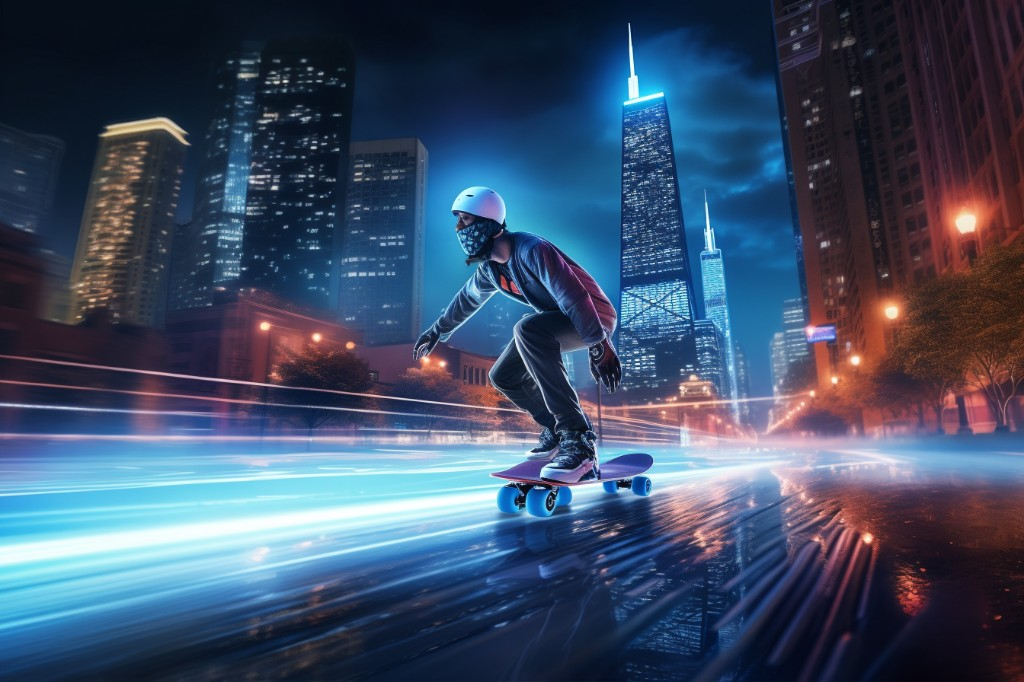
The Role of Weather Protection and Emergency Repair Kits
Regardless of whether you are a novice or expert skateboarder, one thing remains common — the need for weather protection gear and an emergency repair kit, especially is you are traveling longer distances.
When we talk about weather protection gear, we’re referring to clothing or accessories designed specifically to shield you from elements. For instance, a waterproof jacket can keep you dry in the rain while thermal wear can keep you warm during winter. Don’t forget sunglasses for sunny days and waterproof gloves to keep your hands dry and warm.
Moving on to emergency repair kits — these are essential for handling unexpected breakdowns during your ride. A typical kit should include a multi-tool with various sizes of hex keys and screwdrivers among other things etc.
Having these tools readily available can prove to be the difference between being stranded and being able to complete your ride successfully. Hence, investing in a good emergency repair kit is a must for every skateboarder.
In summary, weather protection gear ensures you are prepared for all weather conditions while an emergency repair kit helps you deal with unexpected breakdowns effectively.
Post-Ride Maintenance and Care
Post-ride maintenance and care of your electric skateboard are vital to ensure its longevity and optimal performance. This goes beyond simply cleaning off the dirt; it involves checking the board for any damage and making sure all parts are in good working order.
Routine board maintenance includes checking the wheels for any wear and tear, ensuring the trucks are secure, and checking the grip tape for any peeling or damage. If your board is battery-operated, battery care should be part of your post-ride maintenance routine. Always ensure your battery is properly charged before storing it away to maximize its lifespan.
Don’t forget, regular board maintenance is not an option — it’s essential. Making maintenance a habit will help you keep your board in top shape and ensure your rides are safe and enjoyable.

Closing Thoughts
Long-distance electric skateboarding is a thrilling journey that combines adventure, fitness, and endurance. Building the necessary strength for extensive rides is essential, as is the right nutrition to power your journey. Equipping yourself with appropriate gear, understanding the role of your board and its remote control, as well as getting to grips with its advanced features can make a world of difference.
Mastering optimal techniques for long rides, handling high speeds, and overcoming challenges such as hill climbing further enhance your skateboarding experience. Plan your trips carefully, managing battery efficiency to mitigate ‘range anxiety’ and familiarizing yourself with the locations of charging stations.
Once your ride is over, post-ride maintenance and care ensure that your board stays in top condition, and consider carrying a spare battery, as this can provide peace of mind during your long-distance memorable rides.
Frequently Asked Questions
What safety gears are essential for long-distance electric skateboarding?
Essential safety gear for long-distance electric skateboarding includes a helmet, knee and elbow pads, wrist guards, and high-visibility clothing for night rides. Additionally, carrying a weather protection and emergency repair kit can be a lifesaver during unexpected situations.
How does physical fitness impact electric skateboarding abilities?
Physical fitness significantly impacts electric skateboarding abilities. The stronger and more fit you are, the easier it will be to control the skateboard, especially during long-distance rides. Activities like endurance exercises and balance training can help improve your skateboarding skills.
How can I make my electric skateboard battery last longer?
To make your electric skateboard battery last longer, avoid rapid acceleration and high speeds as they drain the battery faster. Also, regularly check the battery’s health and ensure it’s fully charged before setting out on long rides.
What are some tips for handling different terrains during long rides?
When handling different terrains during long rides, lower your center of gravity in rough terrains to improve balance. For uphill climbs, lean forward slightly to maintain stability, and when going downhill, stand upright or lean back slightly.
How can I better prepare for a long-distance electric skateboarding trip?
To prepare for a long-distance electric skateboarding trip, ensure you are physically fit, understand your skateboard’s features, plan your route ahead of time including rest stops and charging stations, pack necessary gear and equipment including a spare battery if possible, check weather conditions and be prepared for any eventualities.

